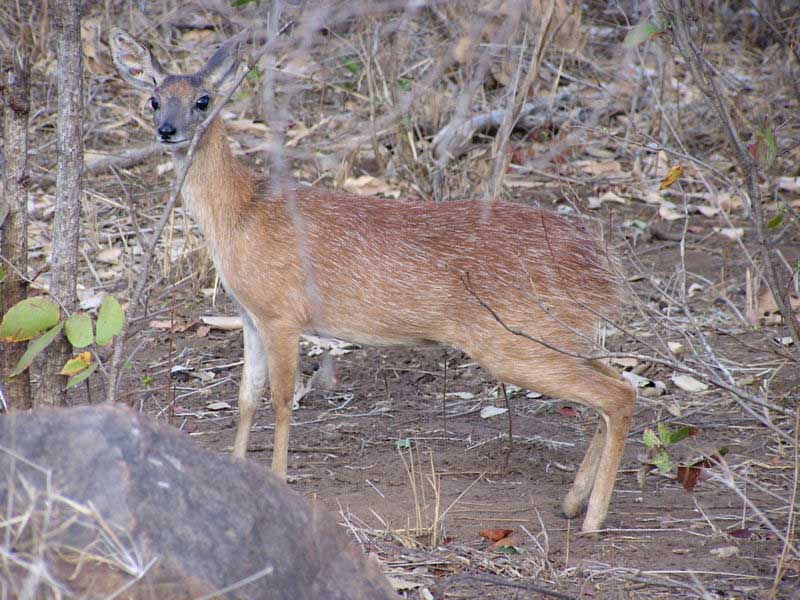
Raphicerus sharpei (*)
Superregnum: Eukaryota
Cladus: Unikonta
Cladus: Opisthokonta
Cladus: Holozoa
Regnum: Animalia
Subregnum: Eumetazoa
Cladus: Bilateria
Cladus: Nephrozoa
Superphylum: Deuterostomia
Phylum: Chordata
Subphylum: Vertebrata
Infraphylum: Gnathostomata
Megaclassis: Osteichthyes
Cladus: Sarcopterygii
Cladus: Rhipidistia
Cladus: Tetrapodomorpha
Cladus: Eotetrapodiformes
Cladus: Elpistostegalia
Superclassis: Tetrapoda
Cladus: Reptiliomorpha
Cladus: Amniota
Cladus: Synapsida
Cladus: Eupelycosauria
Cladus: Sphenacodontia
Cladus: Sphenacodontoidea
Cladus: Therapsida
Cladus: Theriodontia
Cladus: Cynodontia
Cladus: Eucynodontia
Cladus: Probainognathia
Cladus: Prozostrodontia
Cladus: Mammaliaformes
Classis: Mammalia
Subclassis: Trechnotheria
Infraclassis: Zatheria
Supercohors: Theria
Cohors: Eutheria
Infraclassis: Placentalia
Cladus: Boreoeutheria
Superordo: Laurasiatheria
Cladus: Euungulata
Ordo: Artiodactyla
Cladus: Artiofabula
Cladus: Cetruminantia
Subordo: Ruminantia
Familia: Bovidae
Subfamilia: Antilopinae
Genus: Raphicerus
Species: Raphicerus sharpei
Name
Raphicerus sharpei Thomas, 1897
References
Raphicerus sharpei in Mammal Species of the World.
Wilson, Don E. & Reeder, DeeAnn M. (Editors) 2005. Mammal Species of the World – A Taxonomic and Geographic Reference. Third edition. ISBN 0-8018-8221-4.
Vernacular names
English: Sharpe's Grysbok
español: Raficero de Sharpe
suomi: Maa-antilooppi
magyar: Sharpe-őszantilop
svenska: Sharpes grysbok
Sharpe's or northern grysbok (Raphicerus sharpei) is a small, shy, solitary antelope that is found from tropical to south-eastern Africa.
Range
They are found in the Transvaal (South Africa), the Caprivi Strip (Namibia), Botswana, Mozambique, Zimbabwe, Zambia, Malawi and Tanzania to Lake Victoria.
Description
It is similar in size to the gray duiker, but has a stockier body and shaggy fur over the hindquarters. It stands about 20" (45–60 cm) at the shoulders and weighs only 7–11.5 kg. Its coat is reddish-brown streaked with white; eye-rings, muzzle, throat and underside are off-white. The males have stubby horns, which are widely spaced. Sharpe's grysbok has a short, deep muzzle with large mouth and heavy molars for grinding. The short neck and head on a long-legged body result in a high-rumped posture when browsing.
Habits
Although widespread, Sharpe's grysbok is infrequently seen. Males and females seem to form brief associations, but the species is usually encountered singly. Territory is marked with dung middens. Their habitat is rocky hill country, but preferring fertile zones on the lower slopes. They are nocturnal browsers and spend the day in the protective cover of tall grass or shrubs. They are extremely timid and will run away at the first sign of anything unusual, although this flight is accompanied "short stamping hops";[2] they move well away from where the disturbance occurred before stopping (unlike steenbok, which stop and look back).[3] Sharpe's Grysbok are reported to take refuge in aardvark burrows, like steenbok.
Sharpe's grysbok browse on leaves, buds, herb and fruits—in the dry season, their food is typically tough (for which their teeth and jaws are adapted). Grazed grass makes up about 30% of their diet.[2] Like the Cape grysbok they use a communal latrine and mark sticks in its vicinity with pre-orbital gland secretions.[4]
Taxonomy
The closely related Cape (or southern) grysbok (R. melanotis) occurs in the western Cape region. Haltenorth and Diller[5] consider R. sharpei as a subspecies of R. melanotis.
References
Wikimedia Commons has media related to Raphicerus sharpei.
IUCN SSC Antelope Specialist Group (2016). "Raphicerus sharpei". IUCN Red List of Threatened Species. 2016: e.T19307A50193414. doi:10.2305/IUCN.UK.2016-1.RLTS.T19307A50193414.en. Retrieved 12 November 2021.
Kingdon, Jonathan. 1997. The Kingdon Field Guide to African Mammals. Academic Press, San Diego & London. Pp. 386-387. (ISBN 0-12-408355-2)
Smithers, Reay H.N. 1971. The Mammals of Botswana. Museum Memoir No. 4. The Trustees of the National Museum of Rhodesia, Salisbury [Harare], Rhodesia [Zimbabwe]. Pp. 221–222.
Chris; Stuart, Tilde (2000). A field guide to the tracks and signs of Southern and East African wildlife (3rd ed.). Cape Town: Struik. p. 142. ISBN 1868725588. Retrieved 30 July 2015.[permanent dead link]
Haltenorth, Theodor and Helmut Diller. 1980. A Field Guide to the Mammals of Africa including Madagascar. Collins, London. Pp. 53–54. (ISBN 0-00-219778-2)
Ellerman, J.R., T.C.S. Morrison-Scott and R.W. Hayman. 1953. Southern African Mammals 1758 to 1951: A Reclassification. British Museum (Natural History), London. P. 186.
Retrieved from "http://en.wikipedia.org/"
All text is available under the terms of the GNU Free Documentation License

